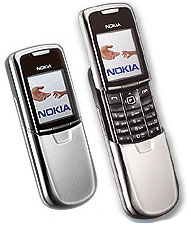Nokia slides out 8800, 8801 luxury phones
News and Photos From InfoSync

Drawing upon modern watchmaking and jewelry techniques, Nokia today unveiled the latest addition to the company's line-up of high-end fashion phones, the 8800. Contained in a stainless steel body, the 8800 follows in the footsteps of the 8910, the last handset unveiled by the company to boast a sliding pop-up mechanism.
Small, yet heavy, the 8800 measures in at a modest 107 x 45 x 17 mm and weighs 134 g, offering tri-band GSM/GPRS/EDGE 900/1800/1900 MHz. Similar to the recently introduced Nokia 6230i, it also boasts an active TFT display with a resolution of 208 x 208 pixels and 262K colour depth, in addition to a 3D image engine.
An integrated SVGA camera offers still shooting at 0.5 Megapixels and video recording at QCIF resolution, with 64 MB of non-volatile memory available for storage - much needed, as the 8800 does not support memory expansion. Additionally, the 8800 also sports music playback functionality for MP3 and AAC encoded audio, and also integrates an FM radio along with Bluetooth for short-range connectivity.
In creating the 8800, Nokia designers employed watch-making techniques, such as the use of metal injection molding on the function keys. A specially reinforced glass, typically used in luxury timepieces, provides added toughness and scratch-resistance to the front display, whilst the pop-up mechanism releasing the handset from its protective cover relies on a bi-stable spring mechanism and stainless steel ball bearings.
Other highlights of the handset include an integrated handsfree speaker and, on the software side, WAP 2.0 microbrowser, full OMA DRM software, the 2.0 version of Nokia's Mobile Wallet secure PIM keeper, Java MIDP 2.0 along with exclusive graphics and UI themes developed specifically for the 8800.
In related news, Nokia today also introduced the Nokia 8801, which shares the specifications of the 8800 but has been designed expressly for the Americas market. The Nokia 8801 is expected to begin shipping in the third quarter of 2005, and will likely feature support for GSM 850/1800/1900 MHz bands.
Oliver


0 Comments:
Post a Comment
Subscribe to Post Comments [Atom]
<< Home